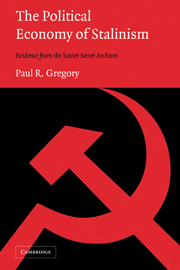Book contents
- Frontmatter
- Contents
- Illustrations
- Tables
- Preface
- 1 The Jockey or the Horse?
- 2 Collectivization, Accumulation, and Power
- 3 The Principles of Governance
- 4 Investment, Wages, and Fairness
- 5 Visions and Control Figures
- 6 Planners Versus Producers
- 7 Creating Soviet Industry
- 8 Operational Planning
- 9 Ruble Control: Money, Prices, and Budgets
- 10 The Destruction of the Soviet Administrative-Command Economy
- 11 Conclusions
- Appendix A Archival Sources
- Appendix B The Structure of the State
- Bibliography
- Index
9 - Ruble Control: Money, Prices, and Budgets
Published online by Cambridge University Press: 03 December 2009
- Frontmatter
- Contents
- Illustrations
- Tables
- Preface
- 1 The Jockey or the Horse?
- 2 Collectivization, Accumulation, and Power
- 3 The Principles of Governance
- 4 Investment, Wages, and Fairness
- 5 Visions and Control Figures
- 6 Planners Versus Producers
- 7 Creating Soviet Industry
- 8 Operational Planning
- 9 Ruble Control: Money, Prices, and Budgets
- 10 The Destruction of the Soviet Administrative-Command Economy
- 11 Conclusions
- Appendix A Archival Sources
- Appendix B The Structure of the State
- Bibliography
- Index
Summary
Money, prices, and finance were not supposed to matter in the administrative-command economy. What counted were the administrative decisions that allocated bricks, machines, wheat, garments, manufactured consumer goods, and labor. This chapter examines a number of issues concerning financial transactions and their components — money, credit, prices, and the state budget. Were money and credit passive instruments of physical planning or “did money matter?” Were money, credit, and prices simply used to track physical transactions and, if so, how well? Or were physical resources allocated based on bidding processes based on financial clout? Given that investment was planned in rubles (see Chapter 4) financed from the state budget, to what extent did the state budget itself determine the physical volume of investment?
This chapter explains why the Soviet financial system did not operate according to this original intent. As financial arrangements evolved, Soviet leaders experienced two money shocks. First, money continued to matter. Enterprise managers sought to accumulate money, especially cash through any means possible, be it unauthorized price increases or nefarious under-the-table transactions. Second, the supply of money and credit could not be kept in line with the supply of real goods, even with a single financial accounting center. Enterprises issued each other illegal credits and used money surrogates when cash was particularly short. The central bank, as the lender of last resort in an economy of soft budgets, was forced to issue credits against its will.
- Type
- Chapter
- Information
- The Political Economy of StalinismEvidence from the Soviet Secret Archives, pp. 213 - 242Publisher: Cambridge University PressPrint publication year: 2003



